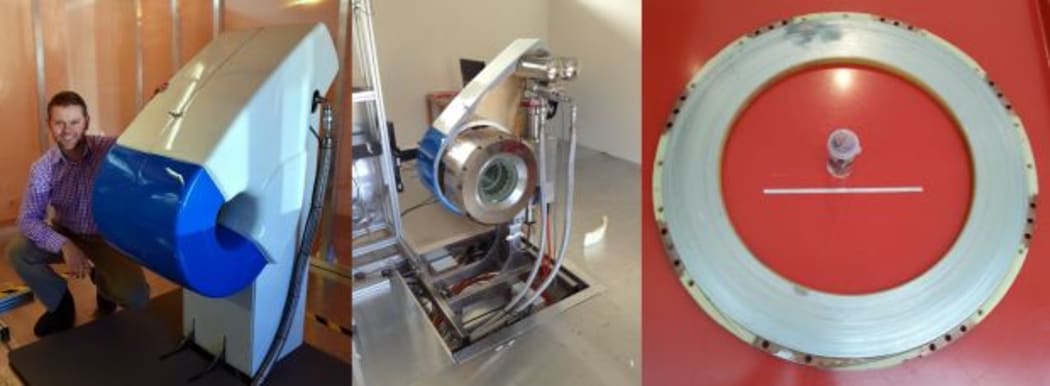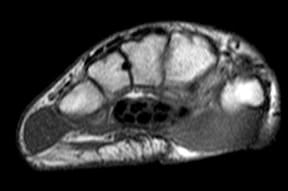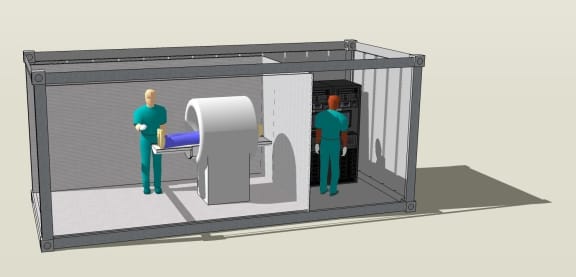By Ruth Beran
A pop-up MRI or magnetic resonance imaging machine that could be transported in a shipping container has been designed by the Robinson Research Institute.
Currently in the concept-stage, a smaller experimental version of the MRI has been developed that can scan human extremities like arms and legs.
MRIs use a magnetic field and radio waves to create detailed images of the organs and tissues inside the body. The machines use superconducting magnets, and at the moment, the large MRI machines in hospitals require liquid helium, a cryogen, to keep the magnets cold.

From left to right: Rob Slade and the experimental MRI, the MRI with covers half off, and a pancake coil Photo: Robinson Research Institute and Ruth Beran
The new MRI, located at Gracefield near Wellington, does not need liquid cryogen because it uses a high temperature superconductor.
A superconductor is a type of electromagnet, but unlike the more common electromagnets made from coils of copper wire, superconductors have no resistance.

An MRI image of a cross section of a hand Photo: Robinson Research Institute
You can leave it on as long as you like, it won’t consume any power,” says physicist and engineer Rob Slade from the Robinson Research Institute.
There is a catch though. Superconductors only work when they are very, very cold.
For example, the superconductors in hospital MRIs need liquid helium to work. “It’s the only liquid which gets cold enough and doesn’t freeze at -269˚C to get the conventional magnet sitting in a liquid,” says Rob.
Liquid helium is expensive in New Zealand. Hospital MRI machines also require a large quench duct to take the helium, which could be an asphyxiation hazard if it boils and turns into a gas, out into the atmosphere.
High temperature superconductors still need low temperatures, but not nearly as cold. For example, the new MRI at Gracefield operates at -253˚C.
This means it can use an electrical refrigeration unit, or cryocooler, instead of a crystat of liquid helium to cool the magnet. This is obviously a disadvantage if there is a power failure but it does mean the machine can be switched on and off, unlike a hospital MRI which is always on. It can also be easily moved.
The experimental MRI has a bore size of 28cm, which is the diameter hole in the middle of the magnet where an arm or leg would be placed. The machine looks a little like a front-loading washing machine and is a similar size.
The magnets are manufactured by the company HTS-110, and are precision wound from 5mm wide tape stiffened with stainless steel to make what Rob calls “pancake coils”. The high temperature superconductor is a ceramic which sits inside the tape. “It looks like an old fashioned tape deck,” says Rob. “And the wire is built up, one turn on top of another to create an annular coil.” The coils are then stacked on top of each other to make the magnets.

Transportable MRI concept Photo: Robinson Research Institute
Creating a human size MRI would require investment to make larger coils but eventually the idea would be to build a machine that is transportable. It was inspired by military requirements for a field hospital.
We think we can fit the whole thing into the back of a shipping container, [and] because you don’t have any of that liquid helium it makes that a more achievable prospect,” says Rob.
If funding is found, the next stage would be to build a prototype.
In 2010, Bob Buckley and Jeff Tallon were awarded the Prime Minister's Science Prize in 2010 for their work on high temperature superconductors. Listen to a previous Our Changing World story with Jeff Tallon here.
Listen to a previous Our Changing World story with Bob Buckley here.
And a story about a cryocooler being developed for use with high temperature superconductors.

